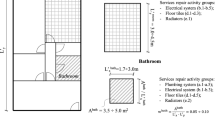Abstract
Construction sector contracts have relevant socioeconomic importance in contrast with its high environmental impact due to the intensive consumption of natural and energy resources throughout the buildings’ service life. Thus, this sector has been object of actions aiming the promotion of low carbon construction and refurbishment given its potential to reduce emissions of greenhouse gases by applying more sustainable materials and techniques. With the development of the building information modeling (BIM) methodology, it is possible to develop the different project specialities in an integrated and collaborative platform since its initial phase, also facilitating the integration of life cycle assessment (LCA). The present work aims to evaluate and compare the environmental impacts of prefabricated concrete elements of new construction and solutions of seismic reinforcement of these elements in an existing building, as well as their costs, through LCA methodology and life cycle cost (LCC). For this purpose, the BIM model of an industrial building with a prefabricated concrete structure was developed and the respective LCA was achieved. It was considered the model of a similar building with 30 years of existence, whose structural calculation not considered the correct strengthening to face seismic actions. The respective seismic reinforcement solution was analyzed, and the corresponding LCA was accomplished. For each case, the LCC was calculated. The analysis of the two buildings highlighted the importance of rehabilitation in the construction sector, since the environmental impacts and the associated costs are reduced when compared to the construction of a new building.









Similar content being viewed by others
References
Antón LÁ, Díaz J (2014) Integration of life cycle assessment in a BIM environment. Procedia Eng 85:26–32. https://doi.org/10.1016/j.proeng.2014.10.525
Arrigoni A et al (2018) Rammed Earth incorporating recycled concrete aggregate: a sustainable, resistant and breathable construction solution. Resour Conserv Recycl 137(March):11–20. https://doi.org/10.1016/j.resconrec.2018.05.025
Asdrubali F, Baldassarri C, Fthenakis V (2013) Life cycle analysis in the construction sector: guiding the optimization of conventional Italian buildings. Energy Build 64:73–89. https://doi.org/10.1016/J.ENBUILD.2013.04.018
Bournas DA, Negro P, Taucer FF (2014) Performance of industrial buildings during the Emilia earthquakes in Northern Italy and recommendations for their strengthening. Bull Earthq Eng 12(5):2383–2404. https://doi.org/10.1007/s10518-013-9466-z
BSI EN 15804 (2014) BS EN 15804:2012—Standards Publication Sustainability of construction works—environmental product declarations—core rules for the product category of construction products, International Standard, p 70
Bui Q-B et al (2019) Vertical rods as a seismic reinforcement technique for rammed earth walls: an assessment. Adv Civ Eng 2019:1–12. https://doi.org/10.1155/2019/1285937
Cabeza LF et al (2014) Life cycle assessment (LCA) and life cycle energy analysis (LCEA) of buildings and the building sector: a review. Renew Sustain Energy Rev 29:394–416. https://doi.org/10.1016/j.rser.2013.08.037
Choi SW et al (2016) Sustainable design model to reduce environmental impact of building construction with composite structures. J Clean Prod 137:823–832. https://doi.org/10.1016/j.jclepro.2016.07.174
Commission European (2017) The energy performance. Context 95:1–6. https://doi.org/10.1109/COMST.2018.2846401
Cype (2019) http://www.geradordeprecos.info. Assessed July 2019
Sérgio Pinho S (2013) ‘O Modelo IFC como Agente de Interoperabilidade: Aplicação ao domínio das estruturas’, Engineering and technology, MsC Thesis. https://repositorio-aberto.up.pt/handle/10216/67927
Dowsett R, Harty C (2013) Evaluating the benefits of BIM for sustainable design—a review. In: 29th Annual ARCOM conference, pp 13–23. http://www.arcom.ac.uk/-docs/proceedings/ar2013-0013-0023_Dowsett_Harty.pdf
EPA U (2012) Tool for the reduction and assessment of chemical and other environmental impacts (TRACI) user’s guide
ISO 14044 (2006) Environmental management—life cycle assessment—requirements and guidelines. https://doi.org/10.3934/dcds.2017153
ISO 14040 (2006) Environmental management—life cycle assessment—principles and framework. ICS 13.020.60-10, p 20
Marteinsson B (2005) Service life estimation in the design of buildings. Doctoral thesis, Sweden
Mateus R (2009) Avaliação da Sustentabilidade da Construção: propostas para o desenvolvimento de edifícios mais sustentáveis. Universidade do Minho, p 427
Motuziene V et al (2016) Construction solutions for energy efficient single-family house based on its life cycle multi-criteria analysis: a case study. J Clean Prod 112(2016):532–541. https://doi.org/10.1016/j.jclepro.2015.08.103
OOCC (2019) https://orcamentos.eu. Assessed July 2019
Ortiz O, Castells F, Sonnemann G (2009) Sustainability in the construction industry: a review of recent developments based on LCA. Constr Build Mater. https://doi.org/10.1016/j.conbuildmat.2007.11.012
Santos R et al (2019) Integration of LCA and LCC analysis within a BIM-based environment. Autom Constr 103(February):127–149. https://doi.org/10.1016/j.autcon.2019.02.011
Schade J (2007) Life cycle cost calculation models for buildings. Department of Civil, Mining and Environmental Engineering Luleå University of Technology, Luleå, Sweden, pp 1–9
Soust-Verdaguer B, Llatas C, García-Martínez A (2016) Simplification in life cycle assessment of single-family houses: a review of recent developments. Build Environ 103:215–227. https://doi.org/10.1016/j.buildenv.2016.04.014
Acknowledgements
This work was financially supported by Project POCI-01-0145-FEDER-028439—“SeismisPRECAST Seismic performance ASSessment of existing Precast Industrial buildings and development of Innovative Retrofitting sustainable solutions,” funded by FEDER funds through COMPETE2020—Programa Operacional Competitividade e Internacionalização (POCI) and by national funds (PIDDAC) through FCT/MCTES.
Author information
Authors and Affiliations
Corresponding author
Rights and permissions
About this article
Cite this article
Raposo, C., Rodrigues, F. & Rodrigues, H. BIM-based LCA assessment of seismic strengthening solutions for reinforced concrete precast industrial buildings. Innov. Infrastruct. Solut. 4, 51 (2019). https://doi.org/10.1007/s41062-019-0239-7
Received:
Accepted:
Published:
DOI: https://doi.org/10.1007/s41062-019-0239-7




